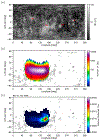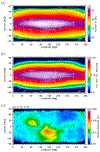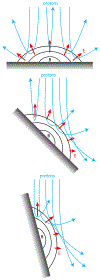ARTEMIS observations of the solar wind proton scattering function from lunar crustal magnetic anomalies
- PMID: 33442502
- PMCID: PMC7802739
- DOI: 10.1002/2017je005313
ARTEMIS observations of the solar wind proton scattering function from lunar crustal magnetic anomalies
Abstract
Despite their small scales, lunar crustal magnetic fields are routinely associated with observations of reflected and/or backstreaming populations of solar wind protons. Solar wind proton reflection locally reduces the rate of space weathering of the lunar regolith, depresses local sputtering rates of neutrals into the lunar exosphere, and can trigger electromagnetic waves and small-scale collisionless shocks in the near-lunar space plasma environment. Thus, knowledge of both the magnitude and scattering function of solar wind protons from magnetic anomalies is crucial in understanding a wide variety of planetary phenomena at the Moon. We have compiled 5.5 years of ARTEMIS (Acceleration, Reconnection, Turbulence and Electrodynamics of the Moon's Interaction with the Sun) observations of reflected protons at the Moon and used a Liouville tracing method to ascertain each proton's reflection location and scattering angles. We find that solar wind proton reflection is largely correlated with crustal magnetic field strength, with anomalies such as South Pole/Aitken Basin (SPA), Mare Marginis, and Gerasimovich reflecting on average 5-12% of the solar wind flux while the unmagnetized surface reflects between 0.1 and 1% in charged form. We present the scattering function of solar wind protons off of the SPA anomaly, showing that the scattering transitions from isotropic at low solar zenith angles to strongly forward scattering at solar zenith angles near 90°. Such scattering is consistent with simulations that have suggested electrostatic fields as the primary mechanism for solar wind proton reflection from crustal magnetic anomalies.
Figures






References
-
- Allegrini F, et al. (2013), Lunar energetic neutral atom (ENA) spectra measured by the interstellar boundary explorer (IBEX), Planet. Space Sci, 85, 232–242.
-
- Angelopoulos V (2011), The ARTEMIS mission, Space Sci. Rev, 165, 3–25.
-
- Auster HU, et al. (2008), The THEMIS fluxgate magnetometer, Space Sci. Rev, 141, 235–264.
-
- Bamford RA, et al. (2016), 3D PIC simulations of collisionless shocks at lunar magnetic anomalies and their role in forming lunar swirls, Astrophys. J, 830, 146.
Grants and funding
LinkOut - more resources
Full Text Sources
